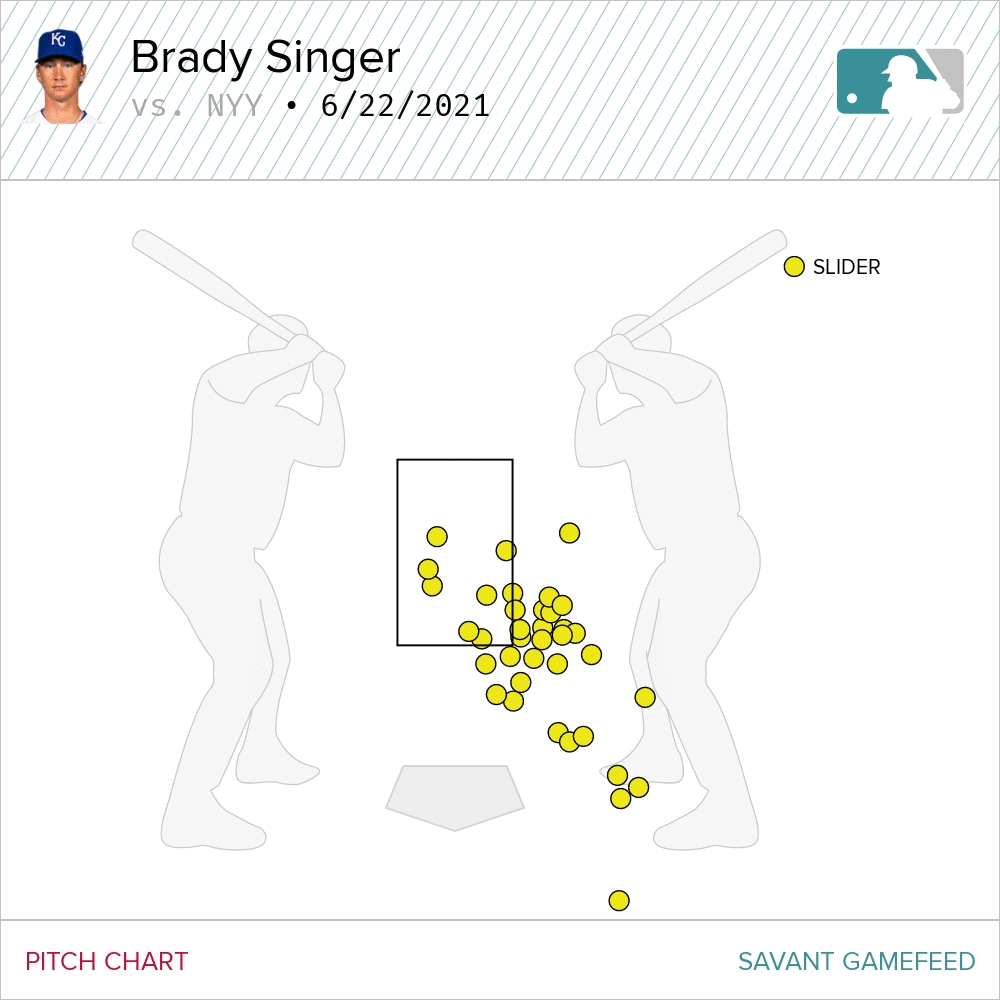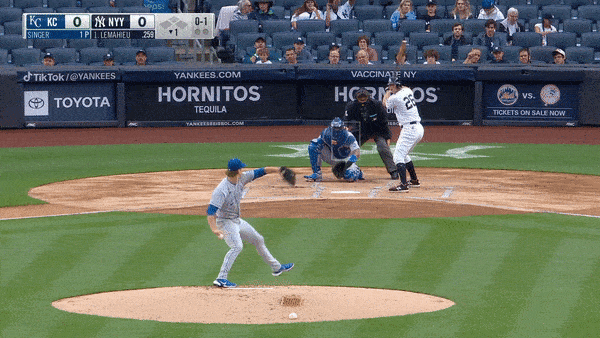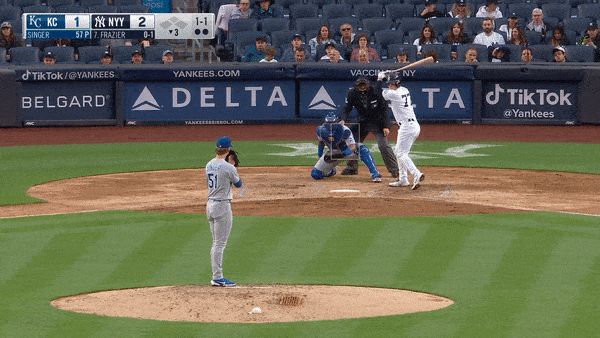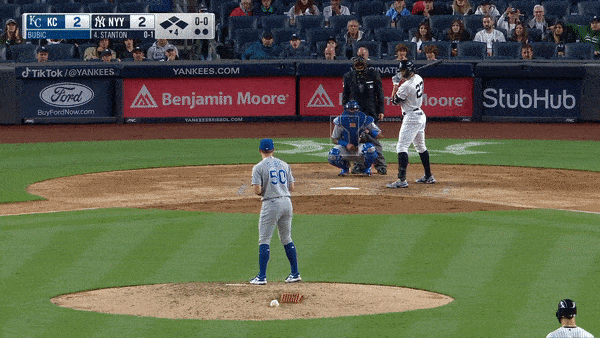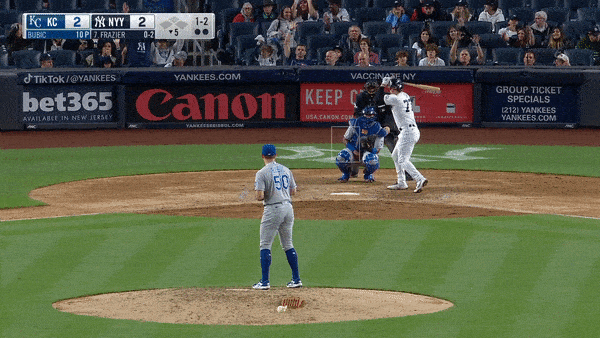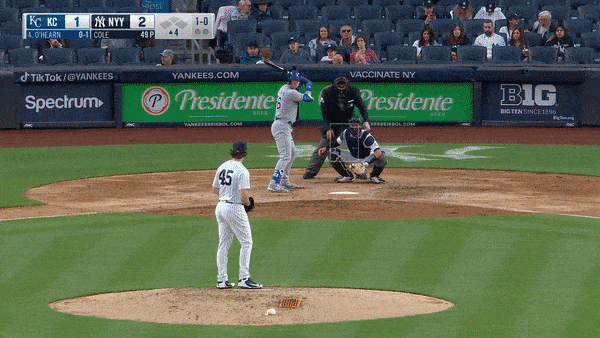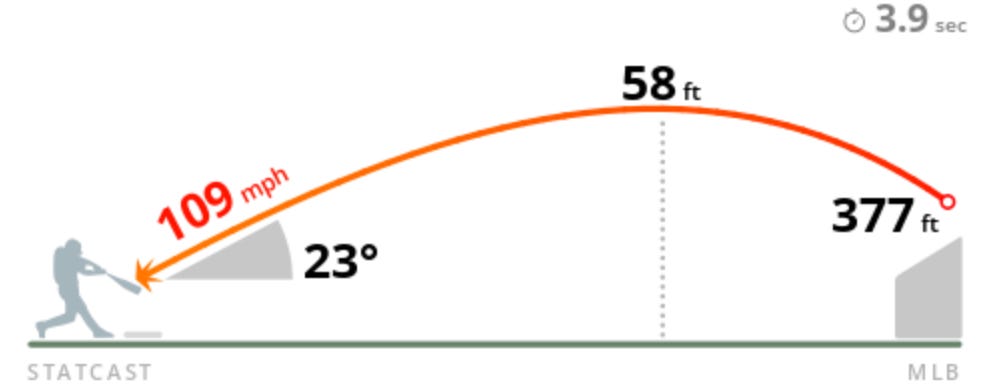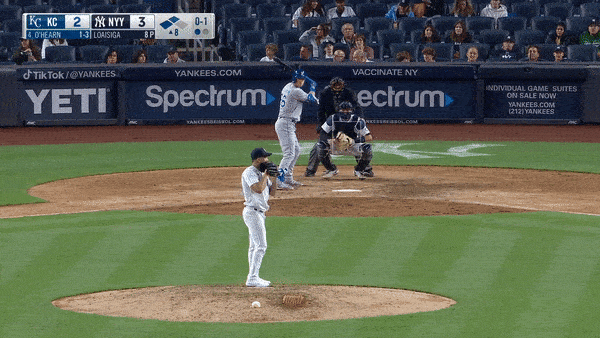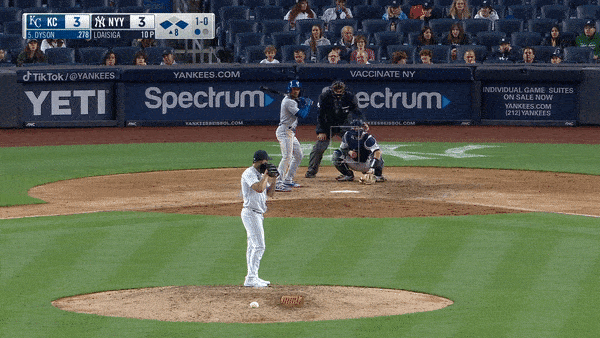Royals keep the line moving to victory
Singer stumbles but Bubic picks him up with a stellar relief outing. O'Hearn returns in a big way. And a late rally sees the Royals through to victory.
It was shaping up to be another grind of a Royals game. Through the first seven innings, they were trailing 3-2 to the Yankees in New York. They were 0-5 with runners in scoring position, their runs coming in familiar fashion: A solo home run and a ground out.
Then they rediscovered that old Royals offensive mojo of keeping the line moving and broke the game open with four runs in the eighth.
There wasn’t anything particularly remarkable from that inning—the first two runs were scored on balls that didn’t leave the infield. But the Royals were able to capitalize on the situation set by the top of their order. By the time Greg Holland secured the final out, the Royals emerged with a hard-fought 6-5 victory over the Yankees. It’s their third win in the last four games.
The song remains the same
In yesterday’s edition, I wrote about Brady Singer and pointed out his struggles in the third and fourth innings. Those were the frames where he was short-circuiting. It won’t necessarily show up in Tuesday’s linescore, but it nearly happened in spectacular fashion.
In the fourth inning, Singer faced five batters and threw a whopping 35 pitches. Not a single pitch was put in play.
That’s just insane. But then again, that’s baseball in 2021.
When Singer ran into issues, it was because he really battled his control on his slider, especially in the first and fourth innings. It’s not a pitch that he’s generally looking to throw in the strike zone, but he was really working well off the plate with the pitch on Tuesday. Too far out of the zone. A lot of these were easy takes for Yankee hitters.
The slider up in the middle of the strike zone was dreadfully located and Luke Voit didn’t miss. The array of pitches just off the zone is where Singer wants to live. It’s where he gets his share of swing and misses and is even able to steal a few called strikes from time to time. Four of his five strikeouts came on the slider, so maybe it’s strange to call it out as not working, but it just reflects the frustration one can have with Singer on the mound. There’s just an inconsistency with the pitch from batter to batter. If he’s working the edges and the batter makes contact, it’s generally going to be weak and on the ground.
You can spot that 1st inning ground out on the chart below, which is where Singer resolved plate appearances with his slider. Note the cluster of strikeouts around the lower corner of the zone. Then note how he pushed down and out just a little too far on the array of walks.
Meanwhile, it was the sinker that was working. Singer finished with a 44 percent CSW% (called strikes plus whiffs) on the sinker which is outstanding. He had 19 swings and seven whiffs on the pitch.
Yankee batters put the pitch in play seven times, but only two were hard hit: One went for a single, the other left the yard. He allowed two other singles on the sinker.
Ultimately, it was Singer’s inability to close out innings that shortened his evening. In the first, he recorded the first two outs then allowed a home run, walk, infield single and walk. He finally closed out the inning on his 21st pitch. He couldn’t bail himself out in the lengthy fourth inning after striking out the first two batters. Again, Singer required 35 pitches in that inning for five batters.
Overall, it was another frustrating start for Singer. I advocated in yesterday’s edition that he was probably better suited to being on a short leash until he developed a third pitch, preferably his change-up. (A pitch he threw only three times on Tuesday.) I’m not sure that 96 pitches is a short leash, but if that’s what it’s going to take to record 11 outs, it’s going to be a brief outing, innings-wise.
Bend it like Bubic
Coming in with the bases loaded in the bottom of the fourth, Kris Bubic announced his presence with authority.
Well, maybe a 78 mph curve isn’t exactly authoritative, but that pitch, in that situation? To that hitter? From Bubic? Cajones.
And you know what? Sometimes, that’s what it takes. The ability to trust your stuff, even if it isn’t your first or second choice. Because major league hitters are sitting on those. Mix it up. See what happens.
Bubic throws his curve around 11.5 percent of the time this year. He may not have total confidence in the pitch, but it’s been a successful one for him in limited exposure. Opponents have just nine hits against it in 41 at bats against it in his career. According to data collected from Brooks Baseball, Bubic will throw a first-pitch curve just 12 percent of the time to right-handed hitters. Giancarlo Stanton clearly wasn’t expecting to be greeted with that kind of bend. You know about hitters ambushing on the first pitch? That was a case of a pitcher turning the tables. That was Bubic ambushing Stanton.
And let’s not minimize that escape. It was a situation where the Yankees were threatening to break the game open in the middle innings. That Bubic was about to get out of that situation, not just on a single pitch, but to keep those potential runs off the board was massive. Especially given how both teams traded scoring opportunities in the later innings.
After he got out of that jam on a single pitch, Bubic turned in an outstanding performance over the next two innings. He kept the change-up down and on the corner. He mixed in only a handful of fastballs and picked his spots with precision early in the count. Five of the seven he offered were the first or second pitches of an at bat. It was running a little livelier than usual, clocking in at 92 mph on average, a couple of ticks higher than his norm. And the separation and location with the change made it a frustrating turn through the order for the Yankee hitters. Look at where Salvador Perez wants this pitch. Look where Bubic delivered.
That’s just perfection.
Really, just everything was working for Bubic. It was the best command I’ve seen from him. Just a pleasing performance all around.
Regular readers will know that I’ve largely praised Mike Matheny and how he’s used his bullpen this year. That Bubic needed only 21 pitches to record seven outs was a gift that the manager needed to hold on to just a bit longer. I know the heart of the Yankee lineup was coming up in the seventh, but Bubic had been so efficient I would have liked to have seen him go at least two more hitters. That’s just second-guessing on my part because I really wanted to see more. He was that good.
Welcome back, Ryan O’Hearn
Ryan O’Hearn was optioned to Omaha on May 28 and just went down to hit. In 57 plate appearances for the Storm Chasers, he’s dominated, hitting .375/.451/.931 with 12 home runs. There isn’t a park that can contain him in the Triple-A Midwest.
Apparently, some of that mojo is transferrable. Look what he did to a Gerrit Cole change up in his second at bat.
That’s 88 mph in and 108.5 mph out. On a rope.
While the dinger was nice and everything, the critical O’Hearn plate appearance came in the eighth. With the Royals trailing 3-2 Whit Merrifield led off with a single and he advanced to third on a Carlos Santana double. After Perez was called out on strikes (on what looked to be a low pitch) the pressure was on O’Hearn to produce.
This was exactly the kind of situation we’ve seen time and time again over the last couple of weeks where the Royals would get in a position to score and ultimately fail to execute. It was such a massive reason why they dropped 11 of 12 in that stretch—just a total failure in clutch situations from the offense.
O’Hearn didn’t hit the ball hard, but he put it in play and placed it perfectly just to the right of the second base bag.
O’Hearn historically has done well when he’s up with a runner on third and less than two outs. In his career coming into Tuesday, he’s had 34 chances in that situation and scored the runner from third 18 times. That’s a 53 percent success rate, just ahead of the major league average of 50 percent. Given the fact that O’Hearn owns an 87 OPS+ in 729 plate appearances in his major league career, I’ll take anything where he’s above average.
O’Hearn tied the game with one out and the Royals continued to capitalize from there. By the time the scoring stopped, the Royals hung four on the board and held a three run lead. They would need every one of those runs.
Still, it was just a great night at the plate for O’Hearn who has struggled in his time in the big leagues since his successful debut in 2018. I remain highly skeptical that he can translate that Triple-A success to sustained production in the majors and I still don’t see how he fits on this roster, but it’s nice to see him cash in on any opportunity the Royals hand to him. Besides, if you’re a left-handed hitter, you’re just begging for the opportunity to hit at Yankee Stadium. Credit to O’Hearn for capitalizing.
Sliding Santana
Following O’Hearn tying the game, if Carlos Santana is going to score the go-ahead run with a headfirst slide across home plate, he’s going to get a gif.
Such grace! I had no idea he could pull that off. (No, I’m not going to call it smooth. That song bugs me. Carry on.) I also greatly enjoyed that Santana’s Dyson-esque slide across the dish came on a ground ball hit off the bat of Jarrod Dyson.
Also, I was raving about O’Hearn’s two productive plate appearances, but take a moment to appreciate the heads-up running from him, briefly stopping as the second baseman Tyler Wade fields the ball. It looks like Wade double-clutched in that moment which was just enough for Santana to get his hand across the plate for a run.
Random spin rate check
In the spirit of these pseudo-strip searches happening across MLB, let’s inspect Gerrit Cole’s spin rates on Tuesday. No need to remove your hat or pull down your pants to look at this chart.
Ummm…those are his lowest spin rates almost across the board since he left Pittsburgh. Very interesting…
Central issues
Reds 10, Twins 7
The Twins stormed back with five runs in the bottom of the eighth to level the score. Alex Kirilloff capped the scoring with a two-run double. But closer Hanser Robles served up a three-run home run to Tyler Naquin to doom the Twins. Just a gut punch level loss.
White Sox 3, Pirates 6
The skid continues for Chicago as Garrett Crochet gave up four consecutive singles to open the seventh and all four eventually came around to score. The White Sox have now lost five in a row.
Cleveland 1, Cubs 7
Cleveland bats could only muster six hits against starter Kyle Hendricks and the Cub bullpen. Willson Contreras and Joc Pederson both drove in two for Chicago.
Up next
Danny Duffy will be activated off the IL and will make the start on Wednesday. It’s perhaps a little surprising that Duffy, who hasn’t pitched since May 12 isn’t going on a rehab assignment to build back his strength. But in his meeting with the media on Tuesday, Duffy said he threw 40 pitches in his last live bullpen session that was two simulated innings. He feels like he’s good for 55 to 60 pitches, but wouldn’t set that limit himself. Duffy says it’s going to be up to Matheny and his pitching coaches to determine how far he can go.
The spot Duffy will be occupying in the rotation was last filled by Kyle Zimmer as The Opener. So Duffy will be filling that role with the option of going an inning or two deeper into the game. If he can go five, that would be a tremendous bonus. The Royals didn’t announce anything, but I would assume Ervin Santana is the first man out of the bullpen if Duffy can only go three or four innings.
Say! If you have a friend who’s a Royals fan, won’t your share Into The Fountains with them?

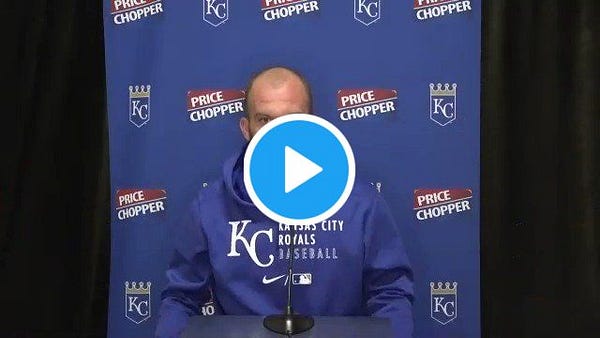
Duffy will face off against Michael King. First pitch is scheduled for 6:05 CDT.





